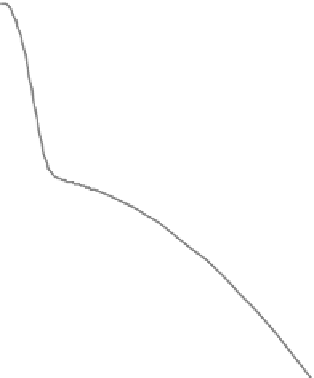Environmental Engineering Reference
In-Depth Information
include experimental data on seed dispersal and to model explicitly the action of
various dispersal vectors (Garnier et al. 2008). The demographic component of the
final model is reduced to a two-stage life cycle (Fig.
16.1
) with seed bank seeds,
mature plants and an annual census occurring just before seed release in summer.
The dispersal component accounts for the successive action of primary dispersal
vectors that disperse seeds from the mother plant to the ground (ballistic dispersal
and verge mowers), followed by the action of secondary dispersal vectors that re-
entrain fallen seeds (wind and vehicles). Mathematically, the global seed dispersal
kernel (
k
- Fig.
16.3
) is thus the convolution of the primary and secondary dispersal
Þ¼
þ1
1
kernels (
k
1
) and (
k
2
):
k
ð
x
k
1
ð
y
Þ
k
2
x
ð
y
Þ
dy
. This convolution describes the
proportion of seeds dispersed from the location 0 to
x
via an intermediate location
y
:
seeds are first dispersed from 0 to
y
by the primary vectors (term
k
1
(
y
)) and then are
subsequently re-entrained from the location
y
to the location
x
by the secondary
vectors (term
k
2
(
x
y
)). This process is summed over all possible intermediate
locations
y
(integration symbol). The environment is supposed to be homogeneous.
Because primary seed dispersal along road verges is likely to occur at both short
distances (ballistic dispersal, known and measured) and long distances (verge
mowers, unknown but assumed to exist at a low frequency), the primary dispersal
kernel (
k
1
) is itself a mixture kernel which sums a small proportion (
p
1
) of dispersal
1
Bal + mow + secondary
Bal + secondary
0.1
Bal
0.01
0.001
0.0001
0.00001
-5
0
5
10
15
20
Distance to origin
x
(m)
Fig. 16.3 The components of the dispersal kernel for feral oilseed rape seeds along road verges.
“Bal”: (primary) ballistic dispersal only; “Bal
þ
secondary”: primary ballistic dispersal followed
by unidirectional secondary dispersal, “Bal
secondary”: global dispersal kernel includ-
ing primary dispersal by ballistic and a small proportion
p
1
þ
mow
þ
¼
0.1 by mowers (mean dispersal
distance by mowers
a
¼
50 m, unidirectional) followed by unidirectional secondary dispersal
























